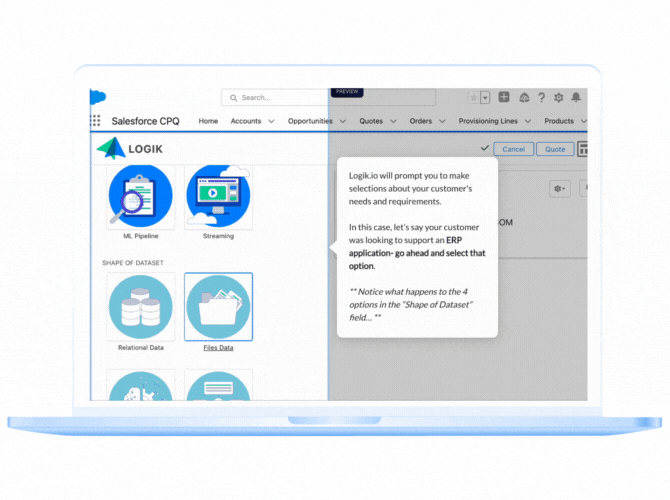Unlocking Sales Potential with a CPQ Configurator
Your Dream CPQ Configurator made for an Easy-to-Manage, Flexible Solution to Selling your Products
Why is Logik.io's Commerce Logic Engine for Product Configuration a Game-Changer?

Flexible & Intuitive
Give your sales reps the tool they need to deliver a quote for products and services that fit exactly what your customer needs. No more picking through part numbers and product lists. Let Logik.io guide every seller to the perfect solution.

Maintain a Single Source of Data
Logik.io enhances the "C" of Salesforce CPQ, and is built directly on the Salesforce platform and within the Salesforce data structure, so you can still leverage all your product data in one central place. Logik.io works right alongside your existing system.

Lightning Fast Speeds
Logik.io adds a proprietary solving engine to Salesforce CPQ built to handle advanced product configurations with split second speed speed for sales reps to produce quotes faster for every product, for every customer, every time.
Table of Contents
Section 1 CPQ Configurator
In today's digital world, things are moving faster than ever. As technology advances and the march of progress rages onward, businesses must keep up with the latest developments in equipment, software, and other tools to remain competitive.
They also have to stay abreast of current business and industry trends.
Since the pandemic, the eCommerce landscape exploded to compensate for the massive and sudden limitations on traditional physical commerce, emphasizing the need for CPQ configurators. This necessitated the most substantial shift modern retail had ever seen and led to the most substantial growth in all of eCommerce history—bar none!
The resulting 2020 mass eCommerce adoption not only constitutes the largest spike in growth since the internet's creation, but it also amounted to a greater expansion than in the previous decade combined! The lockdown and subsequent migration to online stores changed the way people shop as well as what they expect from sellers.
Furthermore, it accelerated the rate of technological evolution. This fast-paced eCommerce landscape requires sellers to be aware of shifting consumer trends. They're shopping online more than ever in expanding product categories, researching more diligently pre-purchase, and they're much more selective and demanding. Today's consumers know their options and they're confident in their ability to find the right products. They're also purchasing more custom items and prefer acting independently.
For all these reasons, businesses increasingly sell customizable items online, utilize guided selling, and embrace headless commerce to help future-proof their businesses. CPQ configurators are key to this strategy. While often unnoticed, product configurator examples exist in all areas of our everyday lives.
While they might not know it, consumers interact with CPQ configurators all the time. From the simple product configurators running fast-food kiosks to the complex product configurators fueling custom car, bespoke home building and remodel, and tailored product manufacturing sales, their massive presence spans almost all industries and it's growing all the time.
Section 2 Salesforce CPQ
As always, there's a never-ending discussion about the best option on the market.
Of course, business software choices can often largely depend on each individual's needs and preferences. To some extent, certain features can be compared empirically to decide which is more powerful or has the most functions.
While that's true, all too often, it's the other, more subjective features that tip the scales when users are choosing a CPQ solution. While, for that very reason, there will never be any real consensus about the top CPQ configurator, there is a general understanding of which one typically gets the most votes.
Using that metric, Salesforce CPQ is widely accepted as the leader in the market. Many attribute its success to the unique Salesforce CPQ architecture providing a superior experience compared to other options. Whatever the reason for their widespread appeal, customers love touting the Salesforce CPQ benefits and top features.
Since it's the most popular, there are many resources available to help users navigate the software. Of course, there's the Salesforce CPQ documentation to help new users install and set up the configurator. It walks you through the steps involved in migrating your data, setting up product rules, and making sure everything follows CPQ implementation best practices
The Salesforce CPQ help section has a lot of useful information, contains a ton of detail, and provides a lot of specific examples. There's also a community help section to ask specific questions to other users like the best Salesforce CPQ pricing options to set up.
Their resources go far beyond that though. The Salesforce CPQ Trailhead courses allow users to become more familiar with the ins and outs of using the platform and helps onboard team members. There are even in-depth Salesforce CPQ certification courses you can take to become a real expert.
Section 3 Why Product Configuration Matters
In modern sales, efficiency and customer experience reign supreme. Product configurators, particularly those integrated with Salesforce CPQ, play a pivotal role in elevating both these aspects. Let's delve into why product configuration matters and how it can transform your sales process.
Impact on Sales Efficiency:
Product configuration tools streamline the sales process by enabling sales teams to quickly and accurately generate quotes tailored to each customer's needs. With Salesforce CPQ configurator, sales representatives can effortlessly configure complex products and pricing structures, eliminating manual errors and reducing quote turnaround time. This efficiency not only enhances productivity but also allows sales teams to focus on building relationships and closing deals rather than getting bogged down in administrative tasks.
Enhanced Customer Experience:
In today's era of personalization, customers expect tailored solutions that meet their unique requirements. Product configurators empower customers to customize products according to their preferences, leading to a personalized buying experience. This level of customization fosters a sense of ownership and satisfaction among customers, increasing their likelihood of making a purchase and fostering brand loyalty. By leveraging Salesforce CPQ product configurator, businesses can deliver an exceptional buying journey that resonates with their customers, ultimately driving sales growth and revenue.
Section 4 Salesforce CPQ Product Configuration
Obviously, the main draw of the software is the Salesforce CPQ product configuration.
While there are many other useful and helpful features, that one is the main purpose and the reason people use it. It helps eCommerce businesses sell customized products that shoppers can design themselves.
CPQ tutorials in Salesforce demonstrate its capabilities and highlight the power of the system in action as well as the many features that make it so beloved by users. They teach people how it works and what steps to take for each desired outcome.
To create uniquely configured, tailor-made products, sales reps and customers using Salesforce CPQ add products, features, extras, and customization options (i.e., color, pattern, amount, material, etc.) in whatever configuration they want—so long as the rules support the option. This provides users with a wide array of options while allowing the business to maintain control of products.
Since most users don't start out knowing terms like configuration attributes, Salesforce CPQ's Trailhead courses teach all the important vocabulary words in the product-specific lexicon. The Salesforce CPQ Trailhead section is often the area users find most helpful since Salesforce CPQ configuration can be a little overwhelming for new users trying to figure it out alone.
The system has a lot of moving parts and requires a lot of initial set-up to perfect the way it works with each business's products. If users are going in with no prior experience or understanding of the way it works, it would be hard to figure it all out without the kind of support Salesforce provides.
So, before users know the difference between product configuration, configuration rules, product rules, configuration fields, and configuration field sets, Salesforce CPQ resources walk them through everything to ensure they gain a comprehensive understanding of the process.
Section 5 How to Build a Product Configurator
Many people wonder how to build a product configurator.
They think that if they could just build a configurator themselves, they could get all the benefits without any of the software costs. They'll research how to build a product configurator in Excel or try to find an open-source product configurator for WordPress.
They often put a lot of time and energy into trying to find the right workaround. Instead of focusing on choosing the right eCommerce product configurator that will save them time, streamline their business, speed up their workflows, and save them money on operating costs while increasing their sales, they put their effort into finding the cheapest solution possible.
This is a mistake. A quality product configurator for websites selling custom products will have a ton of benefits beyond simply the ability to customize products. A spreadsheet that you call a product configurator, on the other hand, will barely allow you to accomplish the absolute minimum, configuration.
It won't have time-saving benefits, in fact, it will likely eat up extra time spent on constant maintenance to make a spreadsheet or weekend coding project do the job of complex business software. It also can't enable guided selling, dynamic pricing, or generate real-time high-quality 3D visuals to reflect product changes. To actually get the benefits, you have to invest in a quality, expert-made, purpose-built solution for eCommerce configuration.
Section 6 Implementation Best Practices
Implementing Salesforce CPQ for product configuration is a strategic decision that can revolutionize your sales operations. However, to ensure a smooth implementation and maximize the benefits, businesses need to follow best practices and address common challenges proactively. Let's explore the key steps and considerations for effectively implementing Salesforce CPQ.
1. Define Clear Objectives:
Before diving into implementation, it's crucial to define clear objectives and goals for deploying Salesforce CPQ. Whether it's streamlining quote generation, improving sales efficiency, or enhancing customer experience, having a clear roadmap will guide the implementation process and measure success.
2. Conduct Thorough Training:
Salesforce CPQ is a powerful tool, but its full potential can only be realized when your sales team is proficient in its usage. Invest in comprehensive training sessions to familiarize users with the features and functionalities of Salesforce CPQ. Providing ongoing support and resources will ensure that your team can leverage the tool effectively.
3. Customize for Your Business Needs:
Every business has unique product offerings, pricing models, and sales processes. Customize Salesforce CPQ to align with your specific requirements and workflows. Leverage the flexibility of the platform to configure product bundles, pricing rules, and quote templates that reflect your business strategy and branding.
4. Integrate Seamlessly:
Salesforce CPQ is most effective when integrated seamlessly with your existing systems and tools. Ensure that it integrates smoothly with your CRM, ERP, and other relevant software to facilitate data flow and process automation. A well-integrated ecosystem will streamline operations and provide a unified view of customer interactions.
5. Address Data Quality and Governance:
Data accuracy and integrity are paramount for successful Salesforce CPQ implementation. Implement robust data governance practices to maintain clean and reliable data within the system. Regularly audit and cleanse your data to avoid inaccuracies that can impact pricing and quoting processes.
Common Challenges and Solutions:
1. Complexity of Products and Pricing:
Complex product offerings and pricing structures can pose challenges during implementation. Break down products into manageable components and establish clear pricing rules to simplify configuration. Leverage Salesforce CPQ's guided selling capabilities to guide users through the configuration process and ensure accuracy.
2. User Adoption and Resistance to Change:
Resistance to change is a common barrier to successful implementation. Foster buy-in from stakeholders by demonstrating the benefits of Salesforce CPQ through pilot programs and success stories. Involve end-users in the implementation process from the outset and address their concerns through training and support.
3. Technical Challenges and Integration Issues:
Technical complexities and integration issues may arise during implementation. Work closely with experienced Salesforce CPQ consultants and IT teams to overcome technical challenges and ensure smooth integration with existing systems. Conduct thorough testing and validation to identify and resolve any compatibility issues.
Section 7 Optimizing Sales with CPQ Product Configuration
Salesforce CPQ (Configure, Price, Quote) isn't just a tool for generating quotes; it's a powerful platform that can revolutionize your sales process and drive revenue growth. By leveraging Salesforce CPQ product configurator effectively, businesses can unlock new opportunities for upselling, cross-selling, and sales forecasting. Let's explore strategies for optimizing sales with CPQ product configuration.
1. Upselling and Cross-Selling Opportunities:
One of the key advantages of Salesforce CPQ is its ability to suggest complementary products or upgrades during the configuration process. Leverage Salesforce CPQ's guided selling capabilities to recommend relevant add-ons, accessories, or higher-tier product options based on the customer's needs and preferences. By presenting upsell and cross-sell opportunities at the point of sale, you can increase the average order value and maximize revenue per customer.
2. Personalized Recommendations:
Harness the power of data-driven insights to deliver personalized product recommendations to customers. Salesforce CPQ allows you to analyze customer data, purchase history, and behavior to tailor product configurations and pricing offers to each individual customer. By offering personalized recommendations that resonate with customers' preferences and buying patterns, you can enhance engagement and increase conversion rates.
3. Dynamic Pricing and Discounting:
Salesforce CPQ enables dynamic pricing and discounting based on various factors such as volume, contract terms, and customer segments. Utilize pricing rules and approval workflows to automate the quoting process and ensure consistency and accuracy in pricing. By offering competitive pricing and targeted discounts, you can incentivize purchases and close deals more effectively.
4. Streamlined Sales Forecasting:
Accurate sales forecasting is essential for effective decision-making and resource allocation. Salesforce CPQ provides insights into sales pipelines, quote metrics, and revenue projections, enabling sales managers to make data-driven forecasts with confidence. By leveraging Salesforce CPQ's reporting and analytics capabilities, you can track sales performance, identify trends, and forecast future sales with precision.
5. Integration with CRM and Marketing Automation:
Seamless integration between Salesforce CPQ, CRM, and marketing automation systems enhances visibility and collaboration across the sales and marketing teams. By aligning sales and marketing efforts, you can identify and prioritize leads, nurture prospects, and accelerate the sales cycle. Leverage Salesforce CPQ's integration capabilities to automate lead generation, qualification, and follow-up processes, driving efficiency and productivity.
6. Continuous Optimization and Iteration:
Salesforce CPQ implementation is not a one-time effort; it requires ongoing optimization and iteration to adapt to changing market dynamics and customer needs. Regularly review and analyze sales performance data to identify areas for improvement and optimization. Solicit feedback from sales reps and customers to fine-tune product configurations, pricing strategies, and sales processes continually.

SHARE